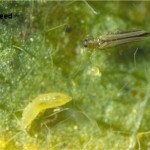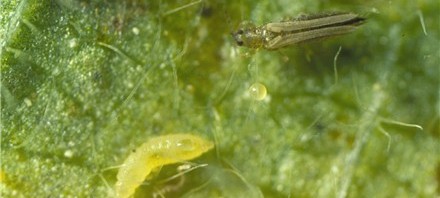 Actually, thinking of thrips as raining from the sky is pretty accurate; and we are getting a pretty good flood in most areas. Many people are reporting 2-15 thrips per plant on cotton from the cotyledon stage up to the second true leaf. These calls are pretty easy to answer. Spray if multiple thrips are present on plants with less than two true leaves. Certainly apply a foliar insecticide if the first or second true leaf has obvious signs of thrips injury … and don’t hesistate … especially if immature thrips are already present.
Actually, thinking of thrips as raining from the sky is pretty accurate; and we are getting a pretty good flood in most areas. Many people are reporting 2-15 thrips per plant on cotton from the cotyledon stage up to the second true leaf. These calls are pretty easy to answer. Spray if multiple thrips are present on plants with less than two true leaves. Certainly apply a foliar insecticide if the first or second true leaf has obvious signs of thrips injury … and don’t hesistate … especially if immature thrips are already present.
Clearly, we are dealing with adult migration that is overwhelming the insecticide seed treatments in many situations. Thrips must feed to be exposed to these systemic insecticides, and continual migration can lead to injury even if they are killing adults. It will be harder deciding if subsequent sprays are necessary as the seedlings begin to grow. Plants will tolerate more thrips as plants get larger, and remember that you may see wrinkled leaves even after application because you can’t reverse damage to tiny, developing leaves that occurred before treatment. There is virtually no data suggesting a third, foliar thrips application will improve yields on cotton having an insecticide seed treatment.
In cotton, the current debate is whether Radiant SC is needed, or whether we can stay with our standards (Orthene/Acephate, Bidrin or Dimethoate). Refer to last week’s article for more detail. Radiant is the product of choice if you are dealing with western flower thrips. Use an adjuvant with Radiant! Most the adult thrips that I’ve observed are dark colored, almost black, indicating they are tobacco thrips, in which case all the above insecticides will work well at typical use rates. Don’t expect more than a few days of residual control with these treatments, but you will see downstream benefits by reducing populations of immature thrips. The immature stages of all thrips are light colored, but so are the adults of several other species including onion thrips, eastern flower thrips and western flower thrips. My observations indicate that tobacco thrips are the predominant species present, but this may vary across the state.
So how do you know if you are dealing with western flower thrips? Because immature thrips are nearly impossible to tell apart, you must rely on adult ID and some detective work. You will need a good hand lens.
- Adult tobacco thrips will be nearly black (see adult pictured above). Adult western flower thrips will be light colored … sometimes described as having an orangish tint. Look for wings to confirm you are looking at the adult stage.
- The presence of immatures, lacking wings, on cotyledon or 1-leaf cotton is a sign of western flower thrips because this species is not well controlled by insecticide seed treatments. Cruiser will typically look a little better than Gaucho if western flower thrips are the predominant species.
- The presence of immatures within a few days following an application of Acephate, Bidrin or Dimethoate is also a sign of western flower thrips. However, finding adults within a few days after an application is not uncommon if there is a large migration occuring, and thus, not necessarily a sign of western flower thrips.
Radiant, which is more expensive, does not seem necessary based on what I’m seeing and reports from the field. However, there may be an advantage to using Radiant for follow-up applications if thrips pressure continues: 1) it is relatively soft on beneficial insects and less likely to flare secondary pests compared with multiple applications of other insecticides, and 2) thrips surviving a first application are more likely to be western flower thrips because Acephate, Bidrin and Dimethoate do not work especially well on this species.
What about soybean? Soybeans are not nearly as susceptible to thrips as cotton, which is good because populations are also typically higher on soybean. Do not use cotton thresholds! Treatment is only occasionally needed in soybean (and very unlikley if an insecticide seed treatment was used). Exceptions prove the rule, and there are examples where foliar insecticides or seed treatments have improved yields when thrips were the only obvious pest present. I am not morally opposed, but I would only treat soybean for thrips when plants are small (prior to the first trifoliate), plants are growing poorly, and thrips are very common.
Leaf cupping, as seen with cotton, is not a typical response to thrips injury in soybean unless populations are extremely high. Indeed, leaf cupping in soybean often indicates herbicide injury (e.g., dicamba).


